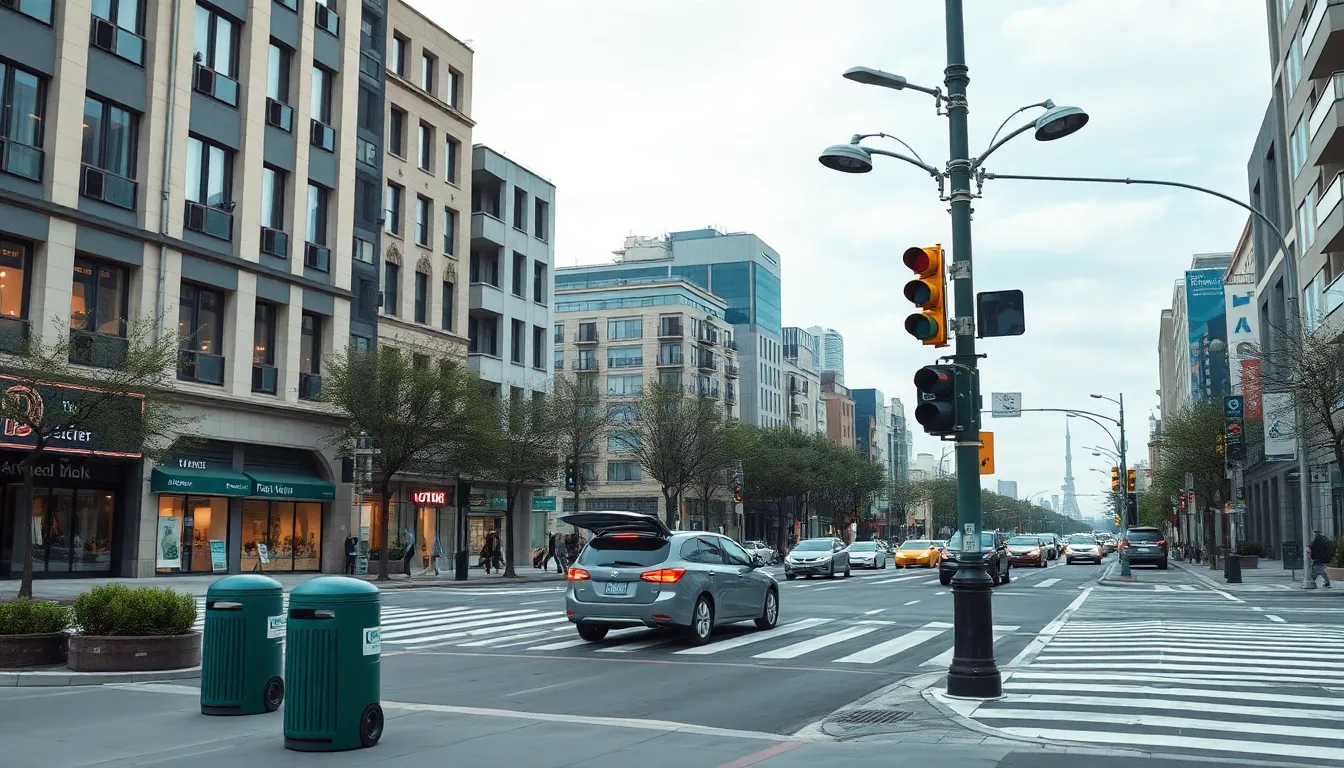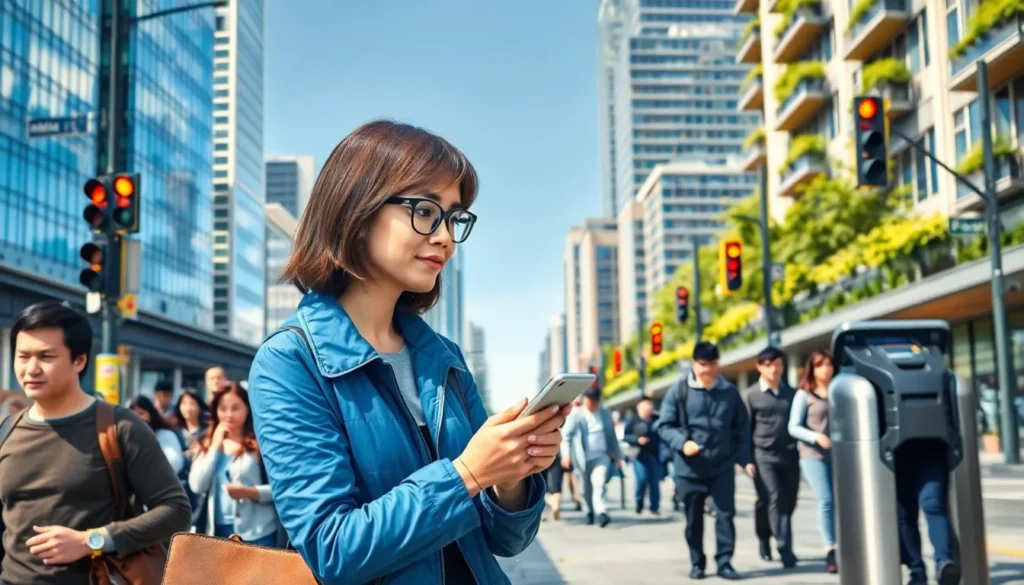Table of Contents
ToggleImagine a city where traffic lights know when you’re running late and adjust accordingly. Picture smart trash bins that alert the garbage truck when they’re full. Welcome to the world of smart cities powered by the Internet of Things (IoT). This isn’t just sci-fi fantasy; it’s happening right now, transforming urban living into a seamless blend of technology and convenience.
As cities grow and populations swell, the need for innovative solutions becomes crucial. IoT offers a way to optimize resources, enhance public safety, and improve the quality of life for residents. With interconnected devices communicating in real-time, cities can tackle challenges like traffic congestion and energy consumption more effectively. So buckle up as we dive into how IoT is reshaping urban landscapes into smarter, more efficient environments—because who wouldn’t want a city that knows them better than their own mother?
Overview of Smart Cities
Smart cities utilize technology to enhance urban living conditions. These cities leverage the Internet of Things (IoT) to create efficient systems that benefit residents and urban infrastructure. Advanced sensors and connected devices work together to monitor and manage resources effectively.
Urban planners focus on data-driven solutions for traffic management. Real-time traffic signals help reduce congestion and improve response times for emergency services. Additionally, intelligent street lighting systems adjust brightness based on pedestrian movement, conserving energy while increasing safety.
Waste management services implement smart waste bins. These bins communicate their fill levels to collection trucks, optimizing routes and reducing operational costs. The integration of IoT ensures that waste is collected promptly, preventing overflow and maintaining cleanliness.
Public safety also benefits from smart technologies. Surveillance cameras equipped with AI can detect unusual behaviors, alerting authorities quickly. Emergency response systems utilize location data to reduce response times during crises, enhancing overall community safety.
Environmentally conscious efforts underpin these advancements. Smart cities emphasize sustainable practices and minimize their carbon footprint. Green building technologies and renewable energy sources contribute to a more sustainable urban ecosystem.
By fostering connectedness, smart cities enhance the quality of life for residents. Integrated apps provide real-time information on transport, weather, and local events. This connectivity promotes engagement and improves overall urban experience.
The continuous evolution of smart technology promises further enhancements to urban infrastructure and community resilience. As cities become smarter, they adapt to the ever-changing needs of their populations, ensuring a better quality of life for everyone.
Role of Internet of Things in Smart Cities

The Internet of Things plays a crucial role in the development of smart cities, transforming urban living through connected technology. Powerful sensors and devices create smarter environments that lead to increased efficiency.
Enhancing Infrastructure
Smart cities employ IoT technology to enhance their infrastructure. Advanced sensors monitor road conditions, providing real-time data that helps in maintaining roads and bridges. Connectivity among these devices allows for timely alerts regarding necessary repairs. Intelligent traffic management systems utilize this data for optimizing traffic flow, reducing congestion, and improving travel times. Real-time updates enhance navigation apps, guiding commuters toward less congested routes. Seamless communication between various infrastructure components ensures that cities can adapt quickly to changing demands.
Improving Public Services
Public services see significant improvements with the integration of IoT in smart cities. Smart waste management systems notify collection services when bins reach fill capacity, optimizing routes and reducing collection costs. Emergency response systems rely on IoT data to enhance coordination during crises, enabling quicker responses. Healthcare services benefit from telemedicine solutions, where IoT devices monitor patient health remotely. Public safety enhances through smart surveillance systems that notify authorities of potential threats. Residents enjoy greater access to real-time information, ensuring that they can navigate city life more effectively.
Key Technologies in IoT for Smart Cities
Smart cities rely on various technologies to thrive in an increasingly connected world. Understanding the key components helps illustrate how IoT transformations provide enhanced urban living experiences.
Sensors and Data Analytics
Sensors serve as the backbone of IoT systems, collecting real-time data to create responsive urban environments. These devices monitor everything from traffic patterns to air quality, feeding valuable information into centralized data hubs. Data analytics processes this information, extracting insights that drive efficient decision-making. For instance, traffic management systems utilize sensor data to optimize signal timing, reducing congestion. Additionally, sensors in smart waste bins communicate their fill status, enabling waste collection agencies to streamline operations. IoT-enabled sensors ensure cities adapt quickly to changing conditions, enhancing overall efficiency.
Connectivity Solutions
Connectivity solutions form the vital framework linking various IoT devices across urban landscapes. Wireless networks like 5G and LoRaWAN enable swift data transmission, supporting an extensive range of applications. 5G technology enhances communication between devices, making real-time data exchange possible for services like autonomous vehicles and smart traffic signals. LoRaWAN, on the other hand, provides long-range connectivity for low-power devices, making it suitable for extensive smart city networks. These solutions facilitate seamless interaction among sensors, allowing for responsive systems that benefit residents daily. Investing in robust connectivity infrastructure ensures cities remain interconnected, promoting a smarter urban ecosystem.
Challenges and Considerations
Smart cities face several challenges that stakeholders must address for successful IoT integration. Security and privacy concerns dominate discussions, influencing public trust and participation.
Security and Privacy Concerns
Data breaches pose significant risks, compromising citizens’ sensitive information. Safeguarding against cyber threats requires robust encryption methods and regular software updates. It’s crucial to establish strict data access controls to protect user privacy. With the proliferation of connected devices, the potential attack surface increases, making effective monitoring essential. Urban planners must prioritize compliance with regulations like GDPR to foster public confidence and mitigate risks.
Integration with Existing Systems
Seamless integration of IoT solutions with existing urban infrastructure remains a hurdle. Legacy systems often lack compatibility, complicating upgrades and data sharing. Upgrading infrastructure involves significant investment and potential disruptions. Ensuring interoperability among diverse systems and devices leads to improved operational efficiency. Collaborative efforts between technology providers and city planners can create unified platforms that streamline integration processes.
Future Trends in IoT for Smart Cities
Emerging trends in IoT are poised to transform the landscape of smart cities. Enhanced connectivity through 5G technology supports rapid data transmission, enabling real-time communication between devices. Advanced AI algorithms are now utilized to analyze data from various sources, leading to informed decision-making and improved urban services.
Smart infrastructure is on the rise as cities integrate IoT solutions into transportation systems. Connected vehicles communicate with traffic management systems, reducing congestion and optimizing travel times. Furthermore, dynamic traffic signals respond to real-time traffic conditions, which enhances overall flow.
Energy management represents another focus area. Smart grids enable real-time monitoring of energy consumption, allowing cities to allocate resources efficiently. Renewable energy sources will increasingly integrate into these grids, further promoting sustainability.
Public health initiatives benefit from IoT advancements as well. Wearable health devices track residents’ health metrics, providing data to local health departments. This data facilitates proactive health monitoring and resource allocation in response to emergent health trends.
Smart buildings incorporate IoT technologies to improve energy efficiency and safety. Sensors detect occupancy levels, automatically adjusting lighting and heating systems. Emergency systems within these buildings become more responsive through integrated IoT solutions, enhancing safety measures.
Urban agriculture also gains momentum with IoT integration. Smart sensors monitor soil conditions, streamlining resource usage and increasing productivity. Hence, food supply chains become more efficient, supporting local economies and fostering sustainable practices.
As these trends continue to evolve, the future of smart cities looks promising. Collaboration among stakeholders, including private enterprises and government entities, plays a crucial role in shaping successful IoT integration. Increased public awareness and education about the benefits of such technologies lead to greater acceptance and adoption within communities.
The transformative potential of IoT in smart cities is undeniable. By leveraging advanced technology, urban environments can enhance efficiency and improve the quality of life for residents. With intelligent systems in place, cities can manage resources better and respond to challenges more effectively.
However, the journey towards fully realizing smart cities requires careful planning and collaboration among various stakeholders. Addressing privacy and security concerns remains crucial to building public trust. As cities continue to evolve, embracing IoT solutions will pave the way for sustainable and connected urban living, ensuring a brighter future for all.







